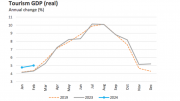Government promotes counter takeover bid for Talgo
The Minister of Transport, Óscar Puente, assures that the takeover bid for Talgo by the Hungarian consortium led by the Magyar Vagón group, which in the past had corporate links with Russian companies, enters the geopolitical scene, since TALGO’s movable axle patent is “critical” in areas such as the Baltic countries where the main concern is “military mobility”. “The context is not easy and Talgo has very sensitive material…. “It…
Read More









